The Cat-fluencers of Instagram: a framework for influencer marketing
People’s loyalty to large influencer accounts on social media can wax and wane, but people’s love of their pets is for life. So what better way to study influencer activity than through catfluencers? (That’s cat influencers for the uninitiated.)
We wanted to get a better understanding of the way people relate to influencers, specifically on Instagram, so we turned to the fascinating world of ‘cat-fluencers’. This is the world of furry felines racking up audiences in their millions and sponsoring a host of products from cat food to CBD oil (read our CBD market research report here). But is any human actually influenced by a product being pushed by a cat on Instagram?
A pet influencer can get almost an 89% increase comments compared to human influencers, according to a 2017 study on US pet owners by Mintel. And while the influencer market is highly saturated, pet influencers can be strong micro-influencers, with their own distinct followings.
In this research report we’ll delve into the world of cat influencers on Instagram and demonstrate how brands and agencies can use this methodology to identify, create and analyze influencer panels to study and engage with for their campaigns:
Table of contents:
Chapter 1: How to identify and actively listen to a catfluencer
Chapter 2: What’s the chat around the cats?
Chapter 3: Uncovering the cat audience: who are the cat lovers?
Chapter 4: Monetizing cats, and what brands they’re working with
Conclusion
Chapter 1: How to identify and actively listen to a catfluencer
The first step to identifying influencers – in any area – is to take a hypothesis-based approach, by having an idea of what you’re looking for, to create context for the search. Finding true influencers is a case of cutting through the noise.
In this instance, we used Pulsar’s audience intelligence tools to follow a ‘funnel’ process and find the cat influencers accounts which are, well, most influential.
Using a little desk research expertise and a few pointers from cat fans, we managed to pull together a chart of the top cats by looking at which accounts were the most mentioned on Instagram.
These are the top cats:
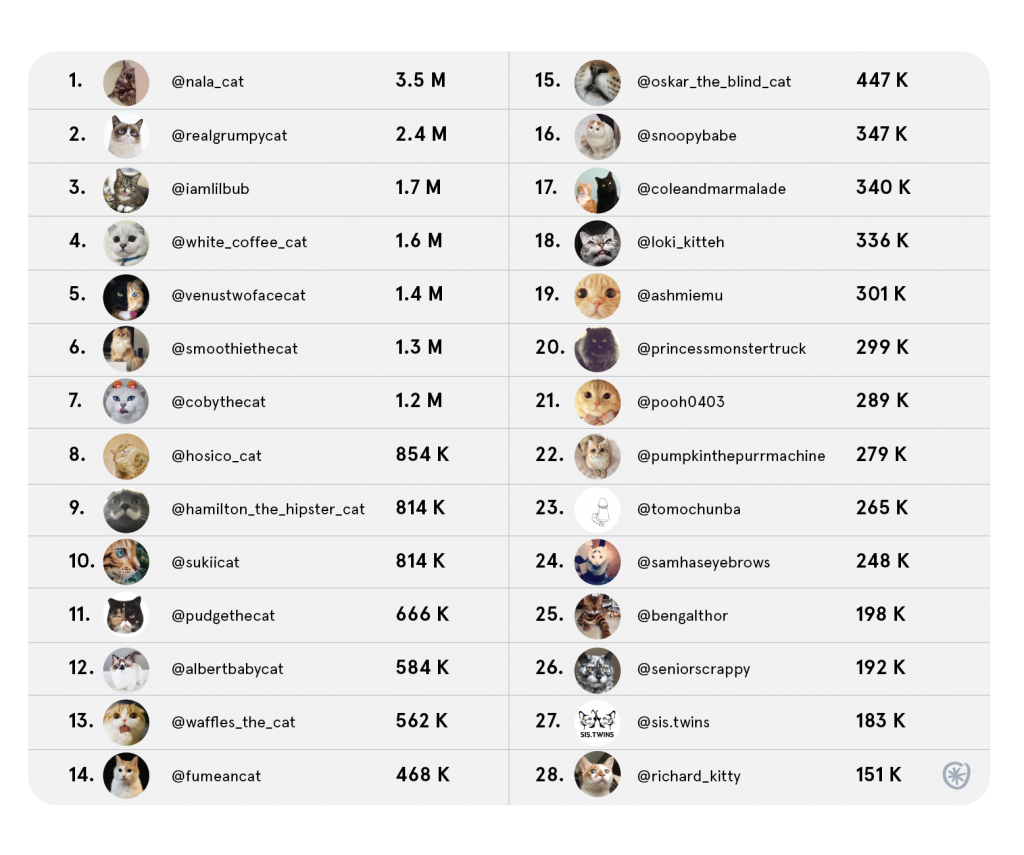
Tracking the catfluencers hype and fan engagement
Once we created our list, we searched for mentions of the feline pets across Instagram and YouTube, to understand how people interact with the biggest accounts. Even pet influencers are nothing without a devoted following, and this allowed us to see which cats people talk about the most, even outside of their own dedicated pages and accounts.
We also conducted a ‘Cat Lovers’ survey of 100 self-identified cat lovers in the US which gave us data broken down by gender/age/locations, as well as the purchase intents and passion areas of these cat fans which we will explore later in the report.
The methodology used to track an influencer looks like this:

Actively listening to and brand monitoring catfluencers
Meanwhile, we added our selection of cat influencers Instagram accounts to Pulsar CORE, our tool used for benchmarking social accounts and analyzing how they perform compared to competitors and industry average. This enabled us to understand the best catfluencer accounts, look deeper into the content they are posting, the overall performance of the accounts, and compare their engagement rates to one another.

Cole & Marmalade and Sukiicat came out as the best performing catfluencers due to their high average engagement rates. With followings of under 1 million, these are not the biggest accounts from our list, however each of their posts drive greater engagement rates in comparison to accounts with bigger followings such as Lil Bub or Nala Cat. Getting these smaller, yet more engaging, accounts to sponsor brands is likely to enact more action.
It’s worth noting that it’s important to keep track of where influence lies at any moment in time – whilst YouTube was strong for cat content five years ago, the rise of Instagram has moved most top cat accounts to this platform, where photos are a much easier form of content to consume than daily or weekly videos. Interestingly, Cole & Marmalade are one of the few Western accounts that remains active on YouTube, where they continue to garner high views and, most importantly, discussion.
Instagram is by far the main platform for influencers at the moment – and while this shows no signs of this slowing down, it’s crucial to understand how the platforms evolve to truly understand influence. For instance, Instagram’s new IG TV offering could provide a new channel for the cat influencers to show off on, or YouTube’s latest paid streaming service might mean that influencers might start creating high quality long-form content which might draw audiences back to that medium. While this isn’t the case at the moment, it’s vital for brands to keep monitoring the movements in the influencer world if they’re truly interested in working with them.
Chapter 2: What’s the chat around the cats?
Once we found our catfluencers, it wasn’t just a case of sitting back and thinking the job was done – understanding how people relate to the accounts, especially if you wanted to investigate working with them for influencer marketing, requires just as much dedication.
Influencers generally are influential within a particular passion network – as we found when we studied passion networks on Twitter – for instance wellness, fashion or music. Certain influencers, such as celebrities, are ‘universally’ influential, but therefore appeal on less of a deep level to audiences with a specific passion.
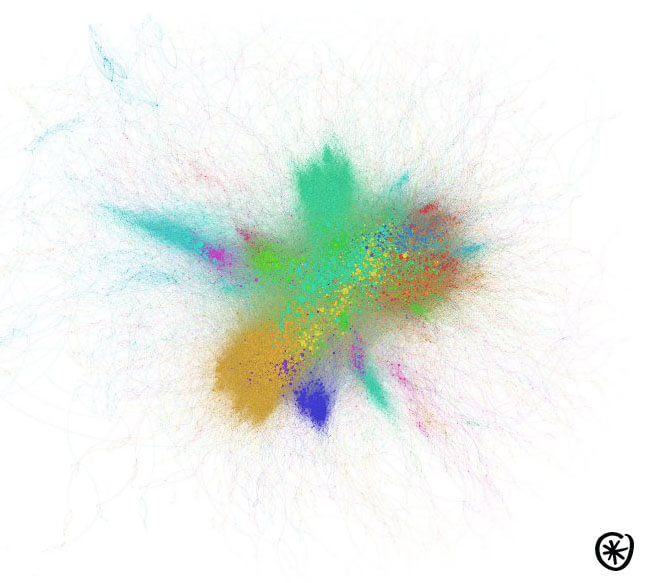
A visualization of the passion networks around music on Twitter. The different colours represent different sub-communities interested in specific styles of music, and shows how these communities interact and cross over, giving a view of audience segmentation and community niches on social media.
Catfluencers therefore, mainly appeal to a segment of cat and cute animals lovers, creating a cat niche.
When looking into some of the most influential cats out there, we found that some of the most successful accounts are moving out of the ‘cat’ niche and into a generic influencer role.
Delving into the conversations
Large followings don’t necessarily mean high share of conversation volume though – using Pulsar TRAC, we followed mentions of some of the top catfluencers over a week and found that Grumpy Cat accounted for 83% of conversation volume, despite having a million followers fewer than the reigning cat queen Nala (@Nala_cat).
Following Grumpy Cat’s rise to the realm of meme A-listers after a post on Reddit, the hashtag #grumpycat has now transcended the cat itself, to represent any cynical or negative mood, which accounts for such a large share of conversation.
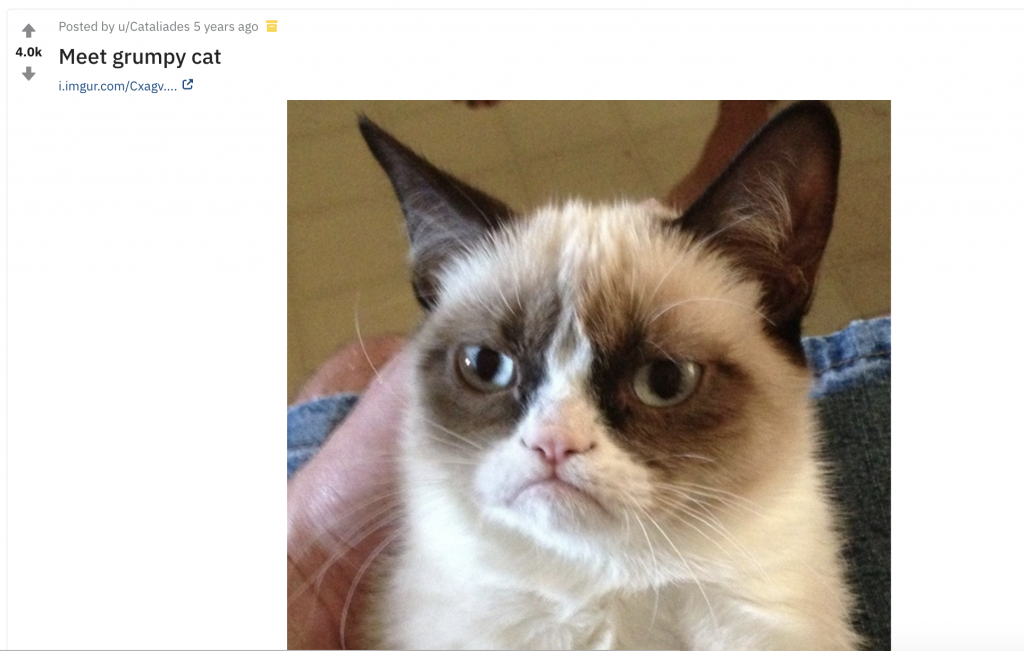
Whilst Grumpy Cat’s fame does correspond to a high following (2.5million), more unusually, catfluencers Cole and Marmalade (@coleandmarmalade) and Mr White (@white_coffee_cat) also have a reasonably large share of conversation volume compared to their much smaller follower size (all below 600k).
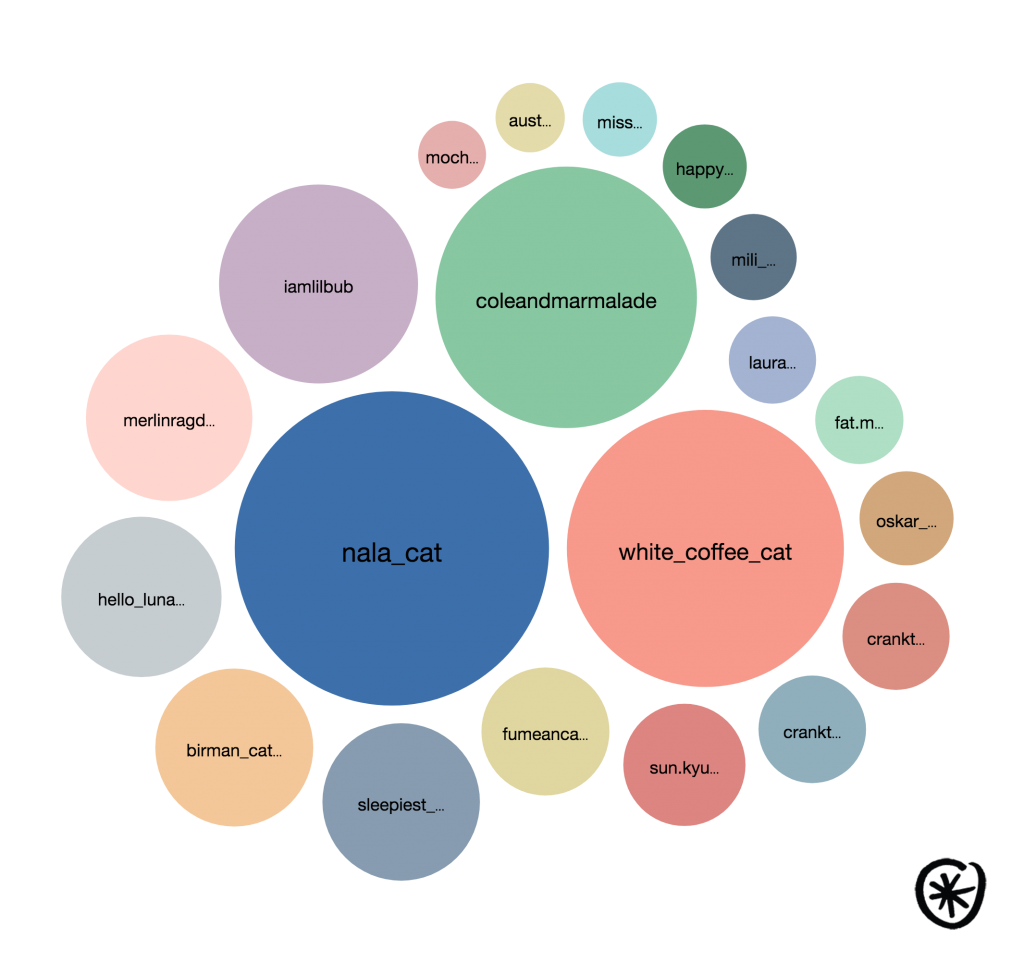
Above: catfluencers represented by visibility in Pulsar TRAC: the larger the bubble the higher the visibility
Furthermore, the influence of the biggest cat accounts broke down into a series of niches. Of the top cat accounts, there are three distinct buckets of catfluencer ‘types’:
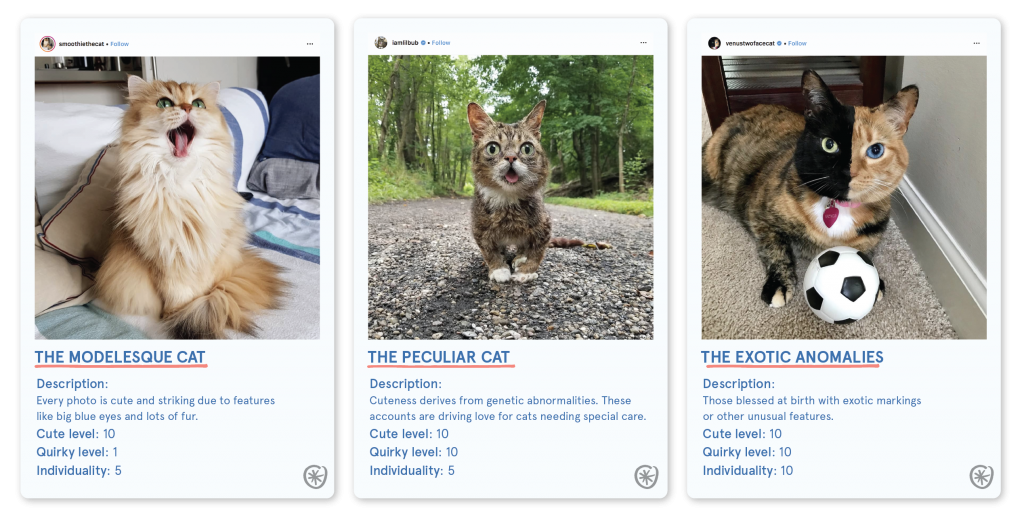
Although ‘exotic anomaly’ catfluencers (like Venus the Two Face Cat, above right) certainly garner large followings due to their novelty, few are particularly break-away influencers who will hit the 1 million follower mark.
Unsurprisingly, the most beautiful cats are most likely to hit those exceptionally large following numbers, as followers know what to expect from these accounts: that every stunning post is going to fit with their carefully curated newsfeed.
Interestingly, other users are tagging photos of their own cats with catfluencers’ names and hashtags, #iamlilbub, #grumpycat etc. to get attention from the top catfluencers, but they are also using hashtags of smaller catfluencers like #wafflesthecat synonymously with these, despite a fraction of the size following (560k compared to 2.5m).
Overall, the conversation around the catfluencers is varied, and shows that cat fans on Instagram are a truly active audience – creating communities around various catfluencer accounts like Cole and Marmalade, who get a huge engagement rate, and tagging their own cats into posts. They are an audience worth understanding.
Chapter 3: uncovering the cat audience, who are the cat lovers?
The audience who are talking about the cats are slightly more skewed towards women, but many accounts posting about cats don’t disclose their gender, showing that many other cat accounts might be involved, showing the self-perpetuating nature of an influencer network.
Cat influencer fans are spread across the world:
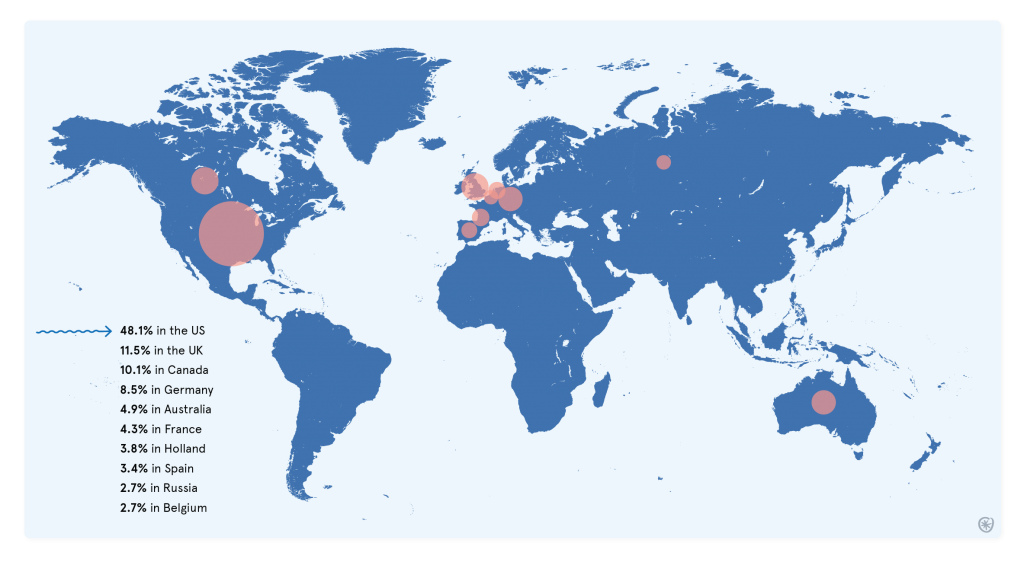
Correlating the cat influencer audience with data of cat fans in the US from our Cat Lovers survey, we found that the gender split of cat fans was fairly even – with 51.2% of cat fans being female, and 48.8% male.
Just under 50% of the Cat Lovers survey respondents who said they follow cat influencers accounts on Instagram were between 45 and 64, and 31.8% were based in the South of the US, with 23.5% in the Midwest.
We can infer from this data that the people in the US who are cat lovers are generally middle-aged people who don’t live in busy urban areas like the Northeast and West of the US, perhaps because they have more time to devote to caring for a pet, and therefore follow accounts like these for to understand similar pet owners – and to see more cats, of course.
There are several passion areas that overlap with a love of cats. 69.5% of survey respondents said they also had a passion for TV, music and film and 65.3% enjoy sport & fitness. Food was the next most popular passion area, enjoyed by 58.6% of respondents. Tech, fashion and politics had fewer votes, but only 1.2% of people said they were interested in none of the passion areas mentioned – showing that the audiences who follow cat influencers will be responsive to collaborations with several types of brands, even if not just in the pet niche.
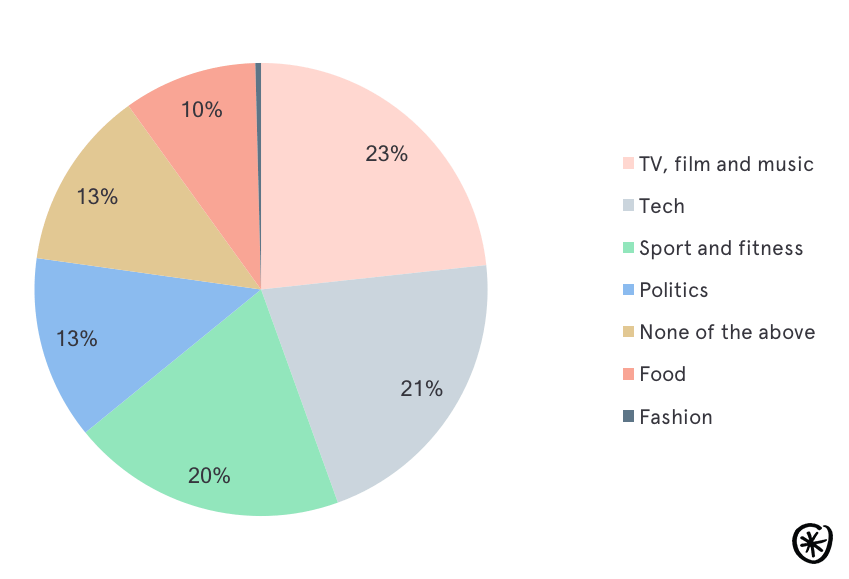
Which leads to the question of sponsored content…
Chapter 4: Monetizing cats, and what brands they’re working with
So you’ve seen a few catfluencers and might be interested in working with them. What to do next?
93% of respondents who follow a cat account on Instagram account said they would consider buying a product promoted by them. 40% of them follow between two and five cat accounts, so there is a strong case to be made for working with Instagram cat influencers for sponsored content.
While ‘human’ influencers feature sponsored posts regularly, one of the advantages to working with a cat influencer is that they appeal to a specific group of cat lovers, but also physically can’t work with many products.
That means campaigns working together will be meaningful and appeal to their audiences – particularly in the case of pet products which can come with a strong recommendation as audiences will literally see the pet with it.
If catfluencers are being used to advertise ‘human’ products, brands looking to work with these influencers will need to get creative in order to come up with a way to keep the cat’s message authentic, while discussing the product at hand. However, as we have seen, interest amongst these audiences is not limited to just a love of animals.
During our research, we found that, as expected, brands selling cat litter, food and flea treatment are top brands sponsoring content in this world of catfluencers – in particular those pushing organic and all natural elements of their products. Interestingly, furniture and mobile apps are also being advertised.
As James Michalak, director of business development at Izea explains to moneyish.com, a successful pet influencer can make up to $15,000 per post as “each collaboration is typically priced on a cost per engagement basis, so on average people can expect to see between $0.50 to $1.00 per engagement — which means likes and comments.”
One fascinating case study includes the use of pet CBD oil: cat influencer Lil Bub @iamlilbub recently featured a post recommending cbdMD’s pet oil:
https://www.instagram.com/p/BmEI9A8l5a9
This follows on from the increasing trend for CBD in the US, which is popular amongst audiences in the general, sport, wellness, and pets audiences, as we found in our recent report on CBD trends:
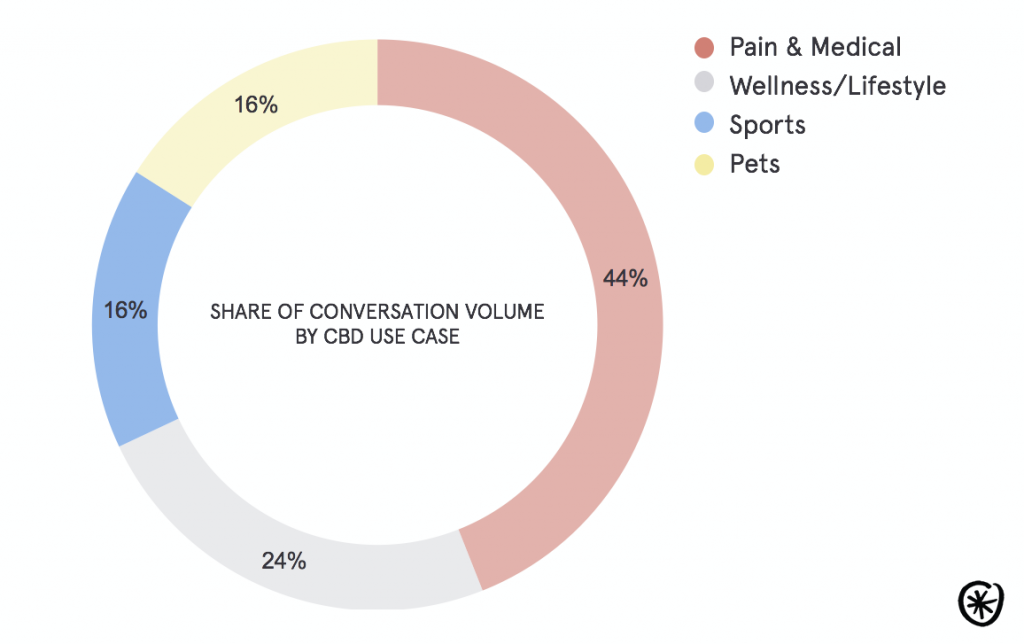
Lil Bub’s owner has made the knowledge of Bub’s various health conditions public – such as being born as the runt of a litter, and the bone condition osteoporosis, and her owner says in the sponsored post that the CBD oil is helping her to sleep.
The post received over 53,000 likes, and hundreds of comments, which the CBD company also stepped in to answer some common questions, helping spread awareness and conversation about the brand and its benefits. They also ran a campaign with Venus the Two Face cat and Nala Cat, amongst others.
Other commonly advertised products include:
Cat food

Cat accessories

Their own merchandise

And some human products too…
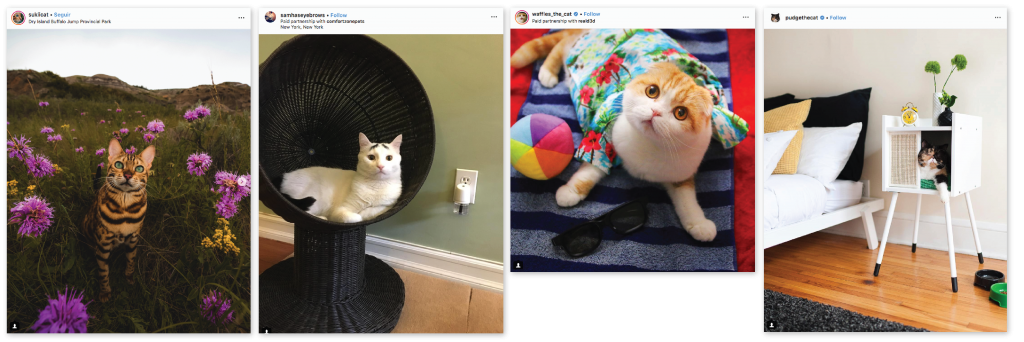
And how do the sponsored posts perform?
Some sponsored posts perform better than others. In particular, videos showing a rare moment not typically shared, like eating, or walking outside, perform well despite being clearly sponsored content.
https://www.instagram.com/p/BjlJ4yJh5do/?taken-by=nala_cat
For smaller catfluencers, content that isn’t obviously an ad drives engagements:
https://www.instagram.com/p/BiJoRORjkYC/?taken-by=pumpkinthepurrmachine
Whilst not every cat does sponsorship, many cats are now such recognisable figures, they are even producing merchandise to further their feline fame.
https://www.instagram.com/p/Bm_UwzvBFFT/?hl=en&taken-by=realgrumpycat
Grumpy Cat is a particularly notable account for this, due to the instant recognition of the cat and “voice” of her images. As such, Grumpy Cat now has her own dedicated cartoon style that is equally recognizable to it’s meme form. Whilst the @realgrumpycat Instagram account is less active than it once was (with few pictures of the cat itself), most posts are now featuring Grumpy Cat products, or the Friskies sponsorship deal that is currently ongoing.
Interestingly, not all cats are taking the opportunity to elevate themselves from a private to business account – where collaborative posts can be clearly labelled under advertising laws – there doesn’t seem to be a correlation with a high follower number and becoming a ‘brand’ instead of a simple account. Whilst some cat accounts are distinctly ‘arty’ – eg. Suki Cat – and hence it may make sense keep it non-business to maintain the aesthetic, this also doesn’t appear to be an explanation.
Conclusion: the takeaways for brands, agencies and wannabe catfluencers
While it might sound inconceivable that cats can be influential, our research shows that this is very much the case, and there’s a lot we can learn from these catfluencer accounts about influence as a whole, Instagram as a platform, and how brands and agencies can work with them.
A few takeaways include:
- Uncovering influence requires careful listening: while researching cat influencers, we found that there was a significant difference between the engagement levels of various cat accounts – while the biggest accounts get huge volumes of followers and impressions, more specific smaller cat accounts actually had higher engagement rates. It’s important to understand what you’re looking for in an influencer when starting research – high following, or a devoted audience?
- Delve down, and then delve again: understanding specific passion areas is vital to understand influence. While we can understand that fans of cat influencers love cats (obviously), we found there are 3 niches within this: beautiful cats, cute cats, and anomalous cats, who audiences love for different reasons. We also found that cat fans are by no way exclusively cat lovers, with an interest in following pet influencers from different species.
- Make a connection and get creative: once you have decided to work with an Instagram cat influencer, it is still just as important to know their back story and passions or interests as with a human influencer, as Lil Bub’s successful collaboration with the CBD company shows.





